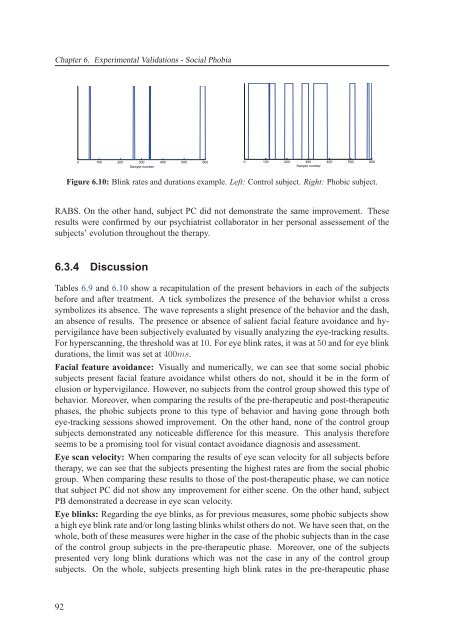Texte intégral / Full text (pdf, 20 MiB) - Infoscience - EPFL
Texte intégral / Full text (pdf, 20 MiB) - Infoscience - EPFL
Texte intégral / Full text (pdf, 20 MiB) - Infoscience - EPFL
Create successful ePaper yourself
Turn your PDF publications into a flip-book with our unique Google optimized e-Paper software.
Chapter 6. Experimental Validations - Social Phobia<br />
0 100 <strong>20</strong>0 300 400 500 600<br />
Sample number<br />
0 100 <strong>20</strong>0 300 400 500 600<br />
Sample number<br />
Figure 6.10: Blink rates and durations example. Left: Control subject. Right: Phobic subject.<br />
RABS. On the other hand, subject PC did not demonstrate the same improvement. These<br />
results were confirmed by our psychiatrist collaborator in her personal assessement of the<br />
subjects’ evolution throughout the therapy.<br />
6.3.4 Discussion<br />
Tables 6.9 and 6.10 show a recapitulation of the present behaviors in each of the subjects<br />
before and after treatment. A tick symbolizes the presence of the behavior whilst a cross<br />
symbolizes its absence. The wave represents a slight presence of the behavior and the dash,<br />
an absence of results. The presence or absence of salient facial feature avoidance and hypervigilance<br />
have been subjectively evaluated by visually analyzing the eye-tracking results.<br />
For hyperscanning, the threshold was at 10. For eye blink rates, it was at 50 and for eye blink<br />
durations, the limit was set at 400ms.<br />
Facial feature avoidance: Visually and numerically, we can see that some social phobic<br />
subjects present facial feature avoidance whilst others do not, should it be in the form of<br />
elusion or hypervigilance. However, no subjects from the control group showed this type of<br />
behavior. Moreover, when comparing the results of the pre-therapeutic and post-therapeutic<br />
phases, the phobic subjects prone to this type of behavior and having gone through both<br />
eye-tracking sessions showed improvement. On the other hand, none of the control group<br />
subjects demonstrated any noticeable difference for this measure. This analysis therefore<br />
seems to be a promising tool for visual contact avoidance diagnosis and assessment.<br />
Eye scan velocity: When comparing the results of eye scan velocity for all subjects before<br />
therapy, we can see that the subjects presenting the highest rates are from the social phobic<br />
group. When comparing these results to those of the post-therapeutic phase, we can notice<br />
that subject PC did not show any improvement for either scene. On the other hand, subject<br />
PB demonstrated a decrease in eye scan velocity.<br />
Eye blinks: Regarding the eye blinks, as for previous measures, some phobic subjects show<br />
a high eye blink rate and/or long lasting blinks whilst others do not. We have seen that, on the<br />
whole, both of these measures were higher in the case of the phobic subjects than in the case<br />
of the control group subjects in the pre-therapeutic phase. Moreover, one of the subjects<br />
presented very long blink durations which was not the case in any of the control group<br />
subjects. On the whole, subjects presenting high blink rates in the pre-therapeutic phase<br />
92

















